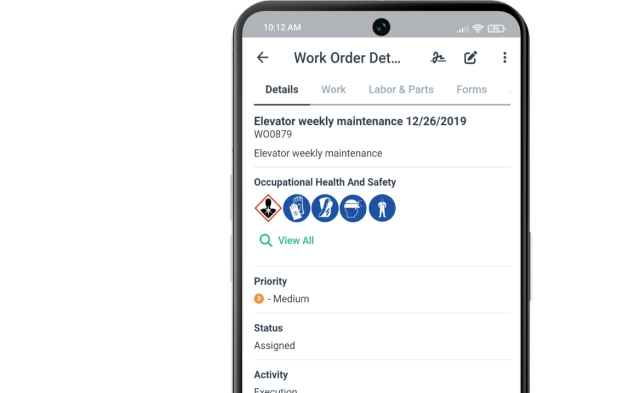Get a Free WorkTrek Demo
Let's show you how WorkTrek can help you optimize your maintenance operation.
Try for freeKey Takeaways:
- Maintenance management software centralizes work orders, preventive maintenance, and asset data.
- 66% of organizations use CMMS to increase reliability, reduce downtime, and improve visibility into maintenance work.
- Only 22% of maintenance professionals currently use EAM systems.
- Compliance can rise from 50% to 99% with automated maintenance schedules and centralized documentation.
Is your maintenance team still drowning in spreadsheets and sticky notes?
Missed PMs, unexpected breakdowns, and confusing work orders are signs of a system that has outgrown manual methods.
Maintenance management software brings clarity, control, and measurable cost savings.
In this article, we will explore what it is, why it matters, the types of tools available, and how real companies benefit from maintenance management software.
What Is Maintenance Management Software?
Maintenance management software is a digital system that helps organizations plan, monitor, and optimize their maintenance activities.
At its core, it replaces paper records and spreadsheets with a centralized platform where all maintenance data is stored, updated, and accessible in real time.
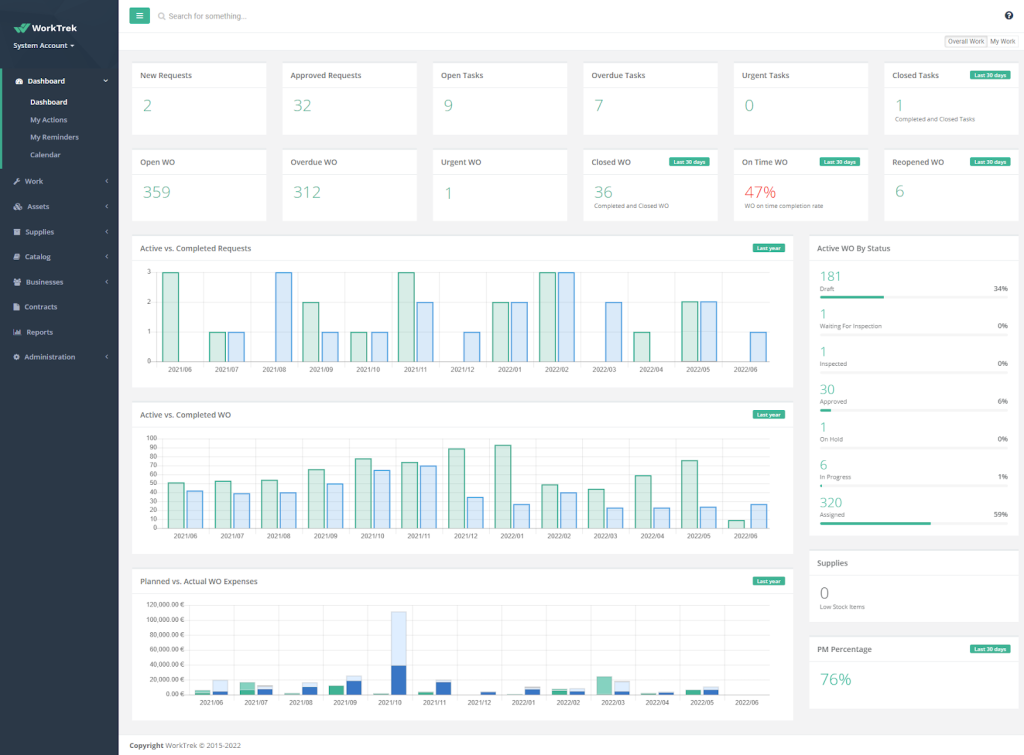
The software typically includes tools for:
- Scheduling and tracking work orders
- Planning preventive maintenance tasks
- Monitoring asset performance
- Managing spare parts and inventory
- Generating reports and KPIs for better decision-making
The use of maintenance management software is growing rapidly.
According to Market Growth Reports, the global market is projected to exceed $1 billion by 2033, with a compound annual growth rate of more than 6%.

Much of this growth comes from organizations moving away from manual processes and siloed spreadsheets toward cloud-based, mobile platforms.
More than 64% of new deployments now take place in the cloud.
This enables easier scaling, integration with other business systems, and mobile access for technicians in the field.
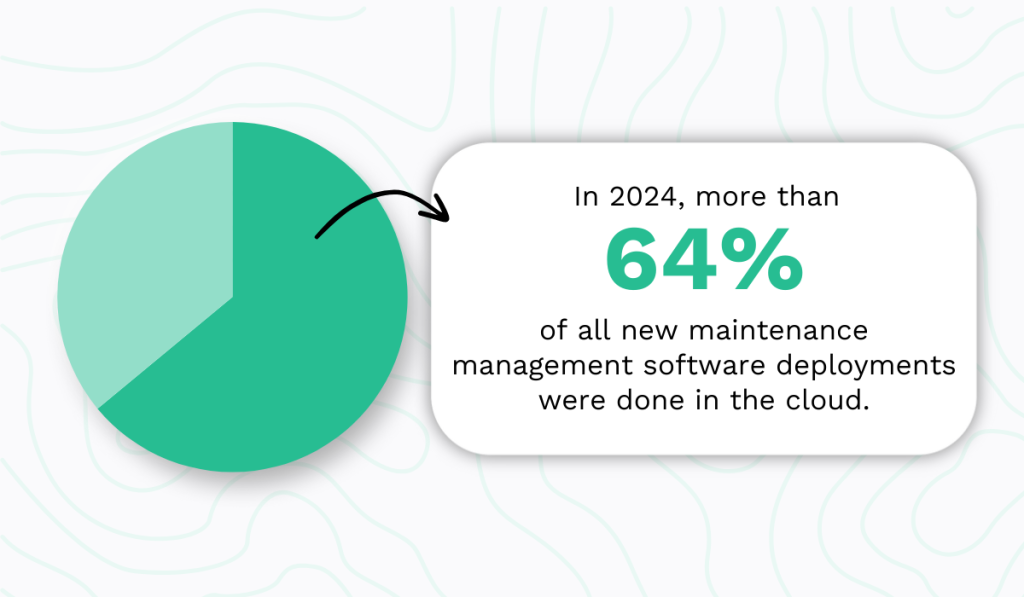
The broader adoption of digital technologies also influences the expansion.
Many companies are combining maintenance management software with IoT sensors, predictive analytics, and artificial intelligence to create more automated and data-driven operations.
These tools support the shift away from reactive maintenance, which has become too costly and unsustainable.
The 2024 State of Industrial Maintenance report by MaintainX reveals that 87% of surveyed facilities are currently utilizing scheduled preventive maintenance, underscoring the widespread adoption of this approach.
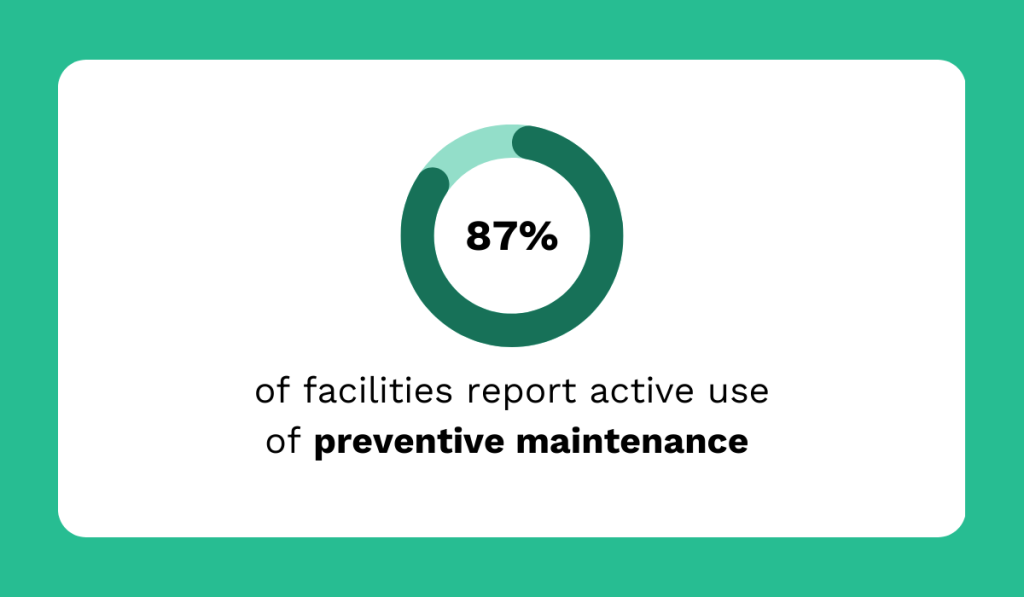
Industries leading the adoption include manufacturing, logistics, energy, public infrastructure, and healthcare, where asset reliability, safety, and regulatory compliance are especially critical.
Types of Maintenance Management Software
There is no one single model of maintenance management software.
Organizations adopt different solutions depending on the size of their operations, the complexity of their assets, and their strategic objectives.
Broadly, these tools fall into three categories: Work order management software, CMMS, and EAM platforms.
Let’s explore each one of these in more depth.
Work Order Management Software
Work order management software is the simplest solution.
With it, maintenance teams can create, assign, and track work orders, giving them a structured way to manage tasks.
Staff can submit work requests, which are then converted into work orders.
You can attach checklists, photos, and other necessary documents to work orders, assign them to technicians, and monitor progress in real time.

For smaller facilities, this provides much-needed work organization without the cost or complexity of more comprehensive platforms.
However, many work order solutions now include advanced features, such as automatically generating follow-up orders for flagged inspections or incomplete jobs.

Some also allow multiple assets to be linked to a single work order, which simplifies complex tasks that involve related equipment.

These capabilities are especially useful for teams managing equipment clusters or multi-step maintenance activities.
Computerized Maintenance Management Systems (CMMS)
CMMS usually has all of the capabilities of work order management software.
It then builds on this foundation by adding a wider set of features, including:
- Preventive maintenance scheduling
- Asset tracking
- Inventory and spare parts management
- Task management
- Reporting and dashboards
- Mobile access for technicians
One of the most important features is preventive maintenance scheduling.
However, instead of relying only on simple calendar-based intervals, CMMS supports task scheduling based on criteria such as usage hours, production cycles, or meter readings.
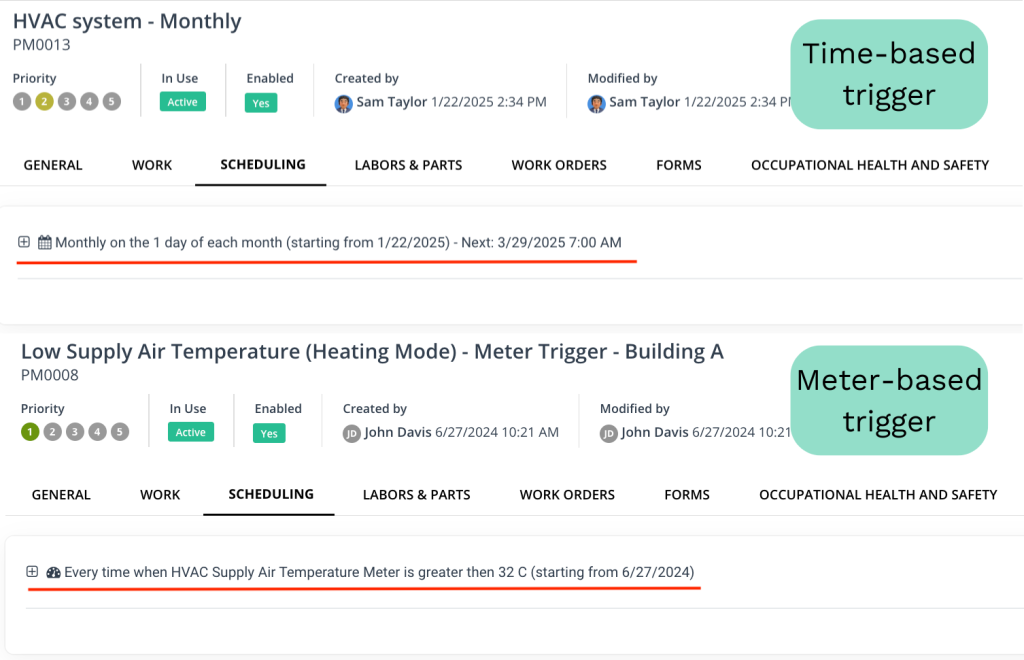
This way, equipment receives maintenance based on its actual condition, rather than arbitrary dates.
Ultimately, this reduces unnecessary interventions while protecting critical assets from premature failure.
CMMS also provides detailed asset tracking.
Every piece of equipment has a complete maintenance history, including past work orders, inspections, and replacements.
Our CMMS WorkTrek, for example, combines all these capabilities with additional functions.
Invoices can be created directly from work orders, covering services, labor, parts, and other related expenses.
Predefined price markups, discounts, and tax rates can be applied to ensure consistency and compliance.

Other features include QR codes that provide instant access to asset histories and interactive floor plans that help technicians locate equipment quickly.

According to the State of Maintenance Report 2024 by UpKeep, 66% of organizations already use CMMS to increase reliability, reduce downtime, and gain greater visibility into operations.
Enterprise Asset Management (EAM) Systems
Enterprise Asset Management (EAM) solutions go beyond CMMS by covering the full asset lifecycle, from acquisition to retirement.
They integrate with ERP, HR, and SCADA systems, and support financial planning, depreciation tracking, contract and warranty management, as well as regulatory compliance.
These expanded capabilities are reflected in higher costs, making EAM more suited to large organizations with complex asset portfolios and strict compliance obligations.
Despite its scope, EAM adoption has declined in recent years.
A survey by the Institution of Mechanical Engineers found that only 22% of maintenance professionals currently use EAM systems, down from 39% the previous year.
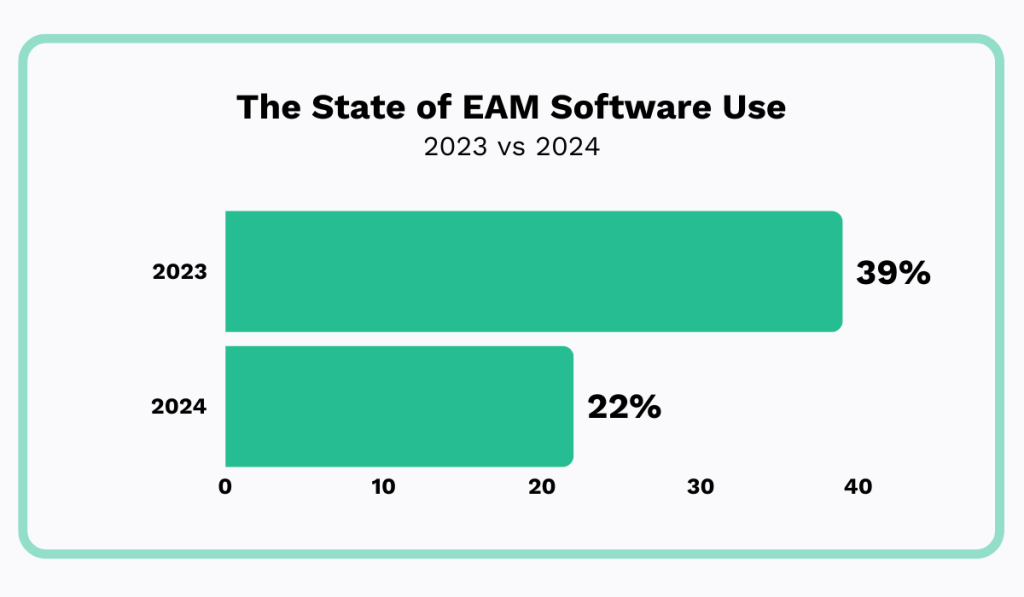
One likely reason is that CMMS platforms have matured into purpose-built solutions that often provide stronger maintenance-focused features at a more accessible cost.
Key Benefits of Using Maintenance Management Software
Adopting maintenance management software has measurable effects on cost, performance, compliance, and team efficiency.
Faster Work Order Resolution
One of the most immediate impacts of maintenance management software is the speed at which work orders are completed.
In manual systems, requests arrive through emails, phone calls, or sticky notes.
Prioritization is unclear, updates are difficult to track, and tasks are often delayed or lost.
This is both inconvenient and expensive.
Unplanned downtime costs manufacturers an average of $125,000 per hour, with costs rising much higher in highly automated or safety-critical industries.
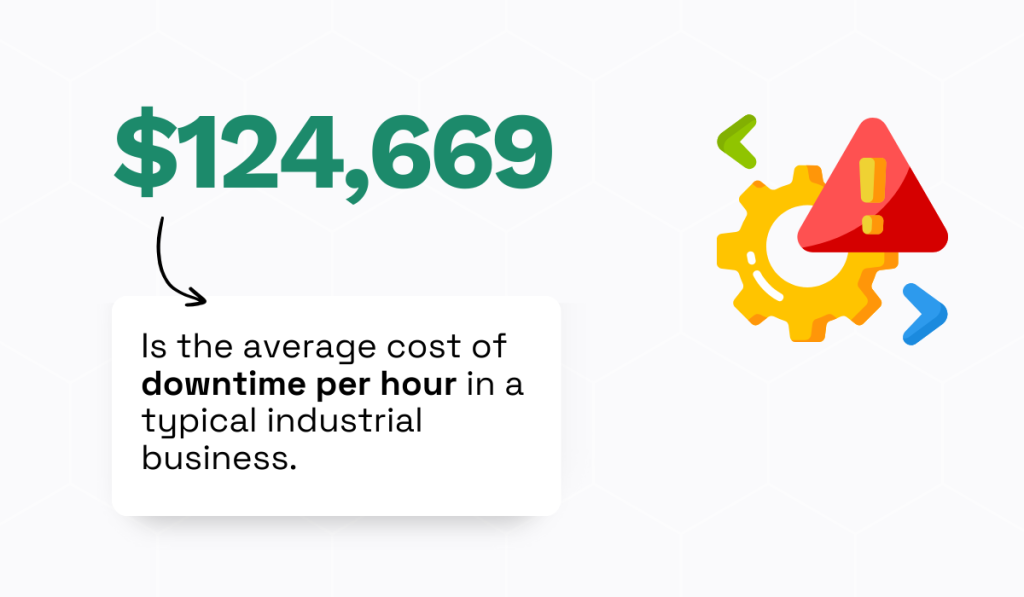
Therefore, every hour saved in resolving work orders directly protects the bottom line.
With a centralized system, managers can:
- Triage incoming requests
- Assign them to technicians based on expertise or availability
- Ensure each task includes the necessary documentation (e.g., procedures, asset history, and safety notes)
This is precisely what the facilities division in Dallas, Oregon, did.
They reduced average turnaround times from several weeks to just a few days after adopting maintenance software.
Facility foreman Matt Butler explained:
“Now, I can triage work requests on a city-wide level and get things scheduled like a doctor’s office.”
Research further supports these outcomes.
The State of Industrial Maintenance Report cited earlier found that shifting from a fully reactive maintenance program to even a partially preventive one reduces unplanned downtime by 32% and improves work order completion rates by 53%.
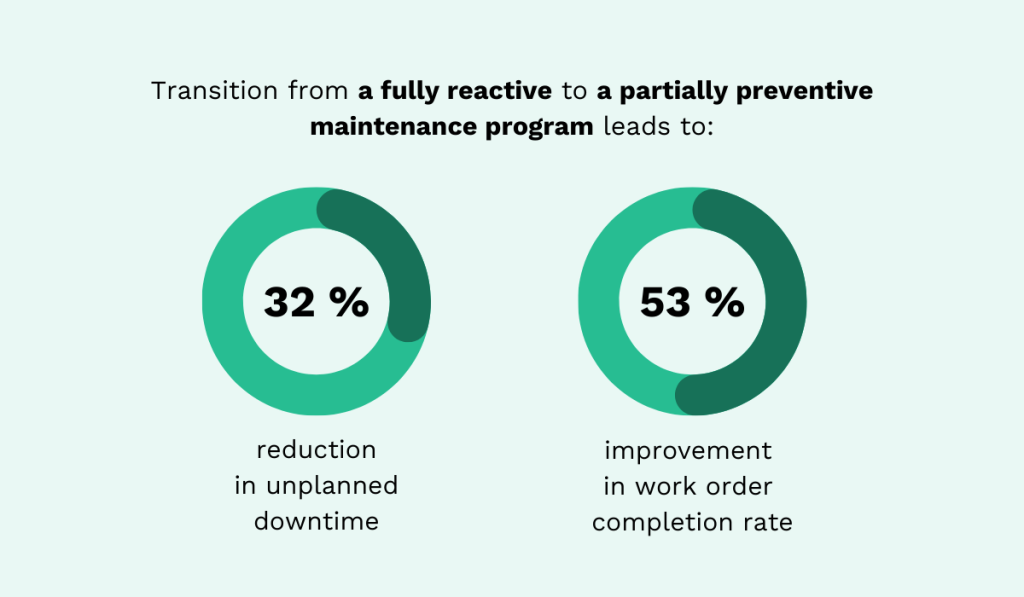
Software plays a central role in this, as preventive maintenance schedules are almost impossible to manage effectively with manual systems.
Lower Maintenance Costs
Reactive maintenance is expensive:
Emergency part orders, overtime labor, and repeated breakdowns often consume large portions of maintenance budgets.
For heavy industrial gearboxes, for example, a single catastrophic failure can cost between $10,000 and $100,000 in repairs, with full replacements exceeding $150,000.
Preventive maintenance programs supported by CMMS platforms can significantly reduce the risk of such events.
Moreover, software enables accurate inventory tracking and efficient labor allocation.
Managers can monitor stock levels to avoid unnecessary purchases and reduce reliance on emergency callouts.
Put all of it together, and the financial impact of preventive maintenance is clear as day.
Zach Williams, Engineering Manager at Kito Crosby Australia, a custom hoists and lifting solutions supplier, summarizes:

Real-world examples confirm the savings, too.
Amalgamated Dairies Limited (ADL), a Canadian dairy processor managing 400 assets across six facilities, achieved significant cost reductions after adopting maintenance software.
By centralizing inventory, assigning labor directly to assets, and monitoring usage, ADL streamlined operations and cut excess costs.
Maintenance Supervisor Thomas Crowell explains:
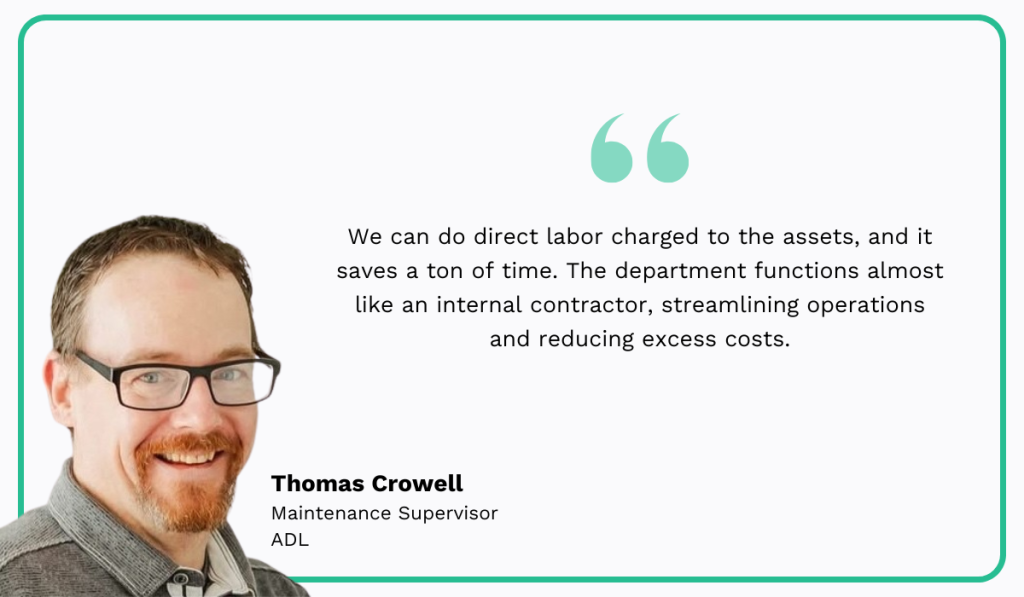
These cases demonstrate how software helps organizations move away from firefighting and toward a proactive model where every dollar spent on labor, parts, and services is optimized.
Increased Regulatory Compliance
In industries like manufacturing, utilities, food production, or pharmaceuticals, staying compliant is legally and operationally essential.
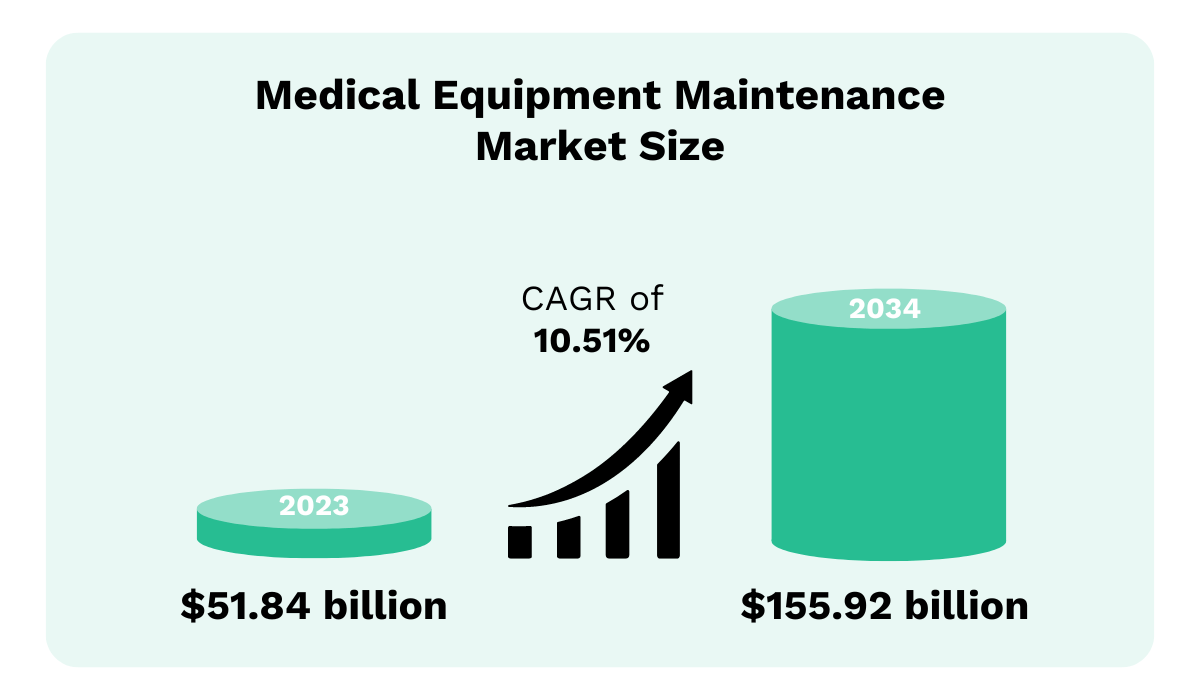
Equipment must be maintained according to strict schedules, safety-critical tasks must be thoroughly documented, and audits can occur at any time.
Without a centralized system, teams risk missing inspections, overlooking documentation, or losing track of regulatory requirements.
The consequences can include fines, legal liability, or even operational shutdowns.
Maintenance management software reduces this risk by automating compliance processes.
Preventive maintenance schedules can be programmed to recur at required intervals, while notifications alert teams well in advance of upcoming inspections or calibrations.
The Futamura facility in Kansas, a leading producer of cellulose packaging film, adopted software precisely for this reason.
Engineering and maintenance manager Paul Whitham explains:
“We have lab equipment that needs to be calibrated to a set standard. We’ve set those assets up in (software)… this system indicates calibration is needed 30 days and 60 days in advance. As the due date approaches, technicians receive a notification and complete the job. That all feeds into a dashboard that tells us our compliance rate.”
This approach to calibration (and other preventive maintenance tasks) led to increased compliance.
Before implementing maintenance management software, the plant’s on-time preventive maintenance completion rate was only 50%.
After the system was deployed, compliance surged to 99%.
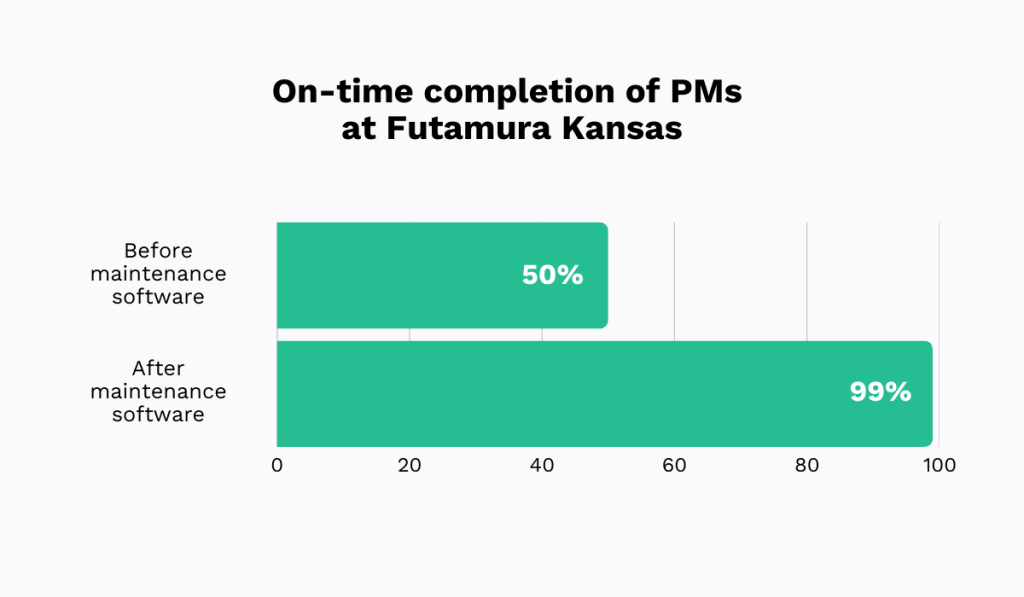
Besides enabling preventive maintenance and ensuring tasks are done on time, maintenance management software stores documentation such as calibration certificates, repair logs, and technician notes in a single, accessible location.

This ensures that all compliance-related evidence is readily available when needed, creating transparency and accountability across the organization.
Increased Team Communication
Maintenance involves many moving parts: multiple technicians, overlapping schedules, different asset types, and urgent requests coming from across the organization.
Without a centralized system, instructions can get lost, status updates go unreported, and teams waste time checking in or waiting for answers.
Maintenance software, especially CMMS, brings everyone on the same page.
In fact, the aforementioned report by UpKeep reveals that for 28% of professionals, improved communication is the top benefit of using a CMMS.
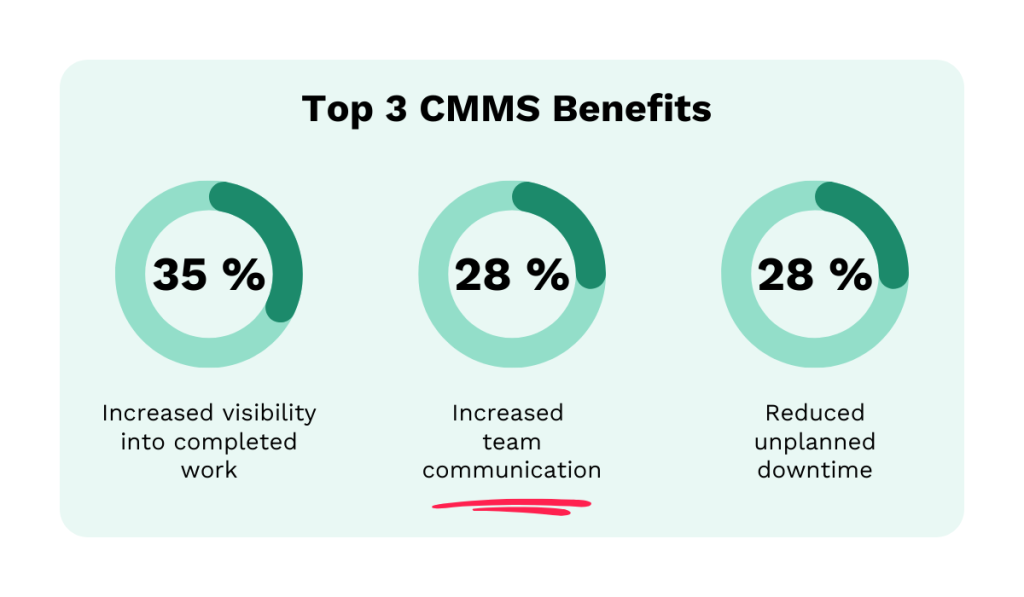
It’s easy to see why.
A CMMS consolidates communication within work orders, dashboards, and mobile applications.
Each work order can contain all the necessary information from the start, including locations, procedures, manuals, photos, and safety checklists.
In a CMMS like WorkTrek, technicians can update progress in real-time, attach notes or images, and even communicate directly through the platform—all from their phones.

There is no need for back-and-forth phone calls or fragmented email chains.
Moreover, WorkTrek’s work request management feature enables anyone in the organization to report issues through a web portal or branded mobile app.
Staff can describe the problem, attach photos, and submit requests instantly, ensuring maintenance teams receive clear, actionable information without delays.
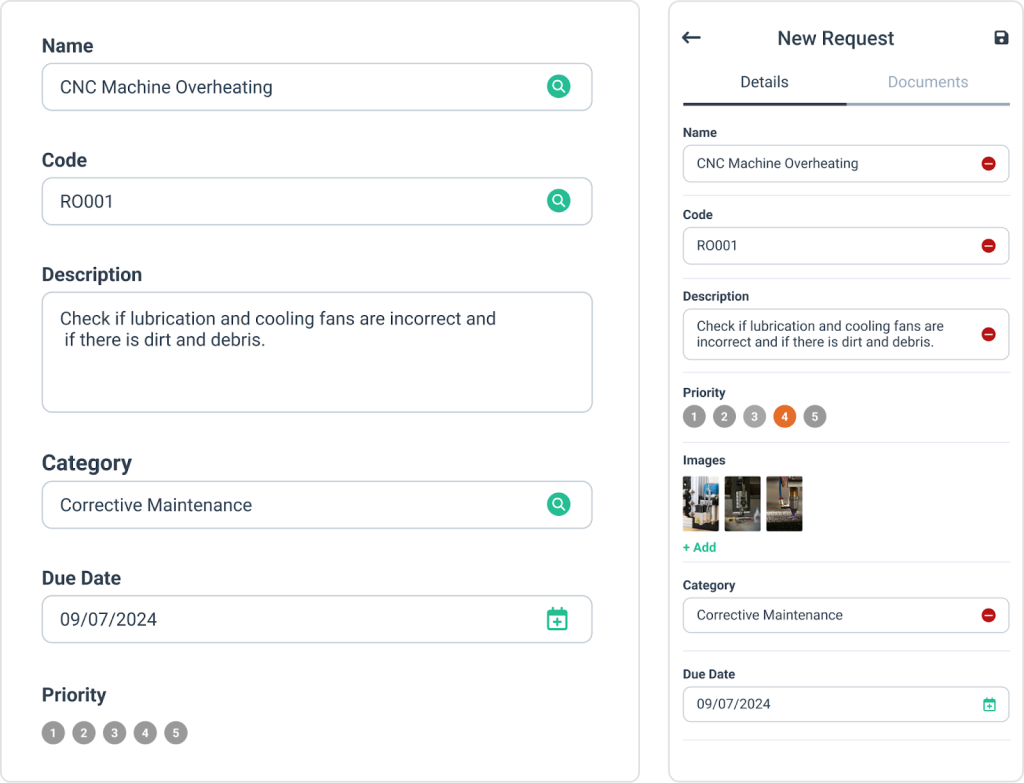
Improved communication has both operational and cultural benefits.
Teams feel more connected, managers have visibility into task progress, and cross-departmental requests are handled with less friction.
The result is a more collaborative environment where information flows seamlessly, supporting the broader goal of efficient, reliable maintenance.
How to Choose the Right Maintenance Management Software
Choosing the right maintenance management software depends on the size of your operations, the complexity of your assets, and your industry’s specific requirements.
In other words, what works for a small facility will not meet the needs of a manufacturer with hundreds of machines across multiple sites.
To make the differences clearer, we created a comparison table that highlights which type of solution fits best under different conditions:
| Factor | Work order management software | CMMS | EAM platform |
| Best for | Small teams, single facilities | Medium–large organizations with many assets | Large enterprises with complex asset portfolios |
| Core focus | Tracking and assigning work orders | Preventive maintenance, asset history, inventory, and reporting | Full asset lifecycle (planning, acquisition, maintenance, disposal) |
| Industry fit | General facilities, schools, and offices | Manufacturing, logistics, healthcare, utilities | Heavily regulated industries (pharma, energy, aviation) |
| Deployment preference | Usually cloud-based, quick setup | Cloud or on-premise, scalable | Often integrated with ERP/SCADA, usually enterprise IT-managed |
| Compliance needs | Basic tracking and documentation | Reporting, audit trails, KPI dashboards | Advanced compliance, warranty, and contract management |
| Ease of use | Simple, minimal training | Balanced between usability and depth | More complex, requires training and change management |
| Cost level | Low | Moderate | High |
This table is not a checklist, but a starting point.
The best choice is the one that balances features with usability, scales with your operations, and fits seamlessly into your existing workflows.
Conclusion
Dallas facilities division, Amalgamated Dairies Limited, and Futamura have seen how maintenance management software changes the daily rhythm of maintenance work.
Work orders get resolved faster, preventive maintenance keeps assets running reliably, and communication flows smoothly across teams.
Technicians spend less time tracking down information and more time focusing on actual repairs and improvements.
When the system fits your operations and your team actually uses it, maintenance stops being a constant firefight and becomes a predictable, manageable part of your business.
So, if you haven’t already, now is the time for you to adopt maintenance management software, too!








